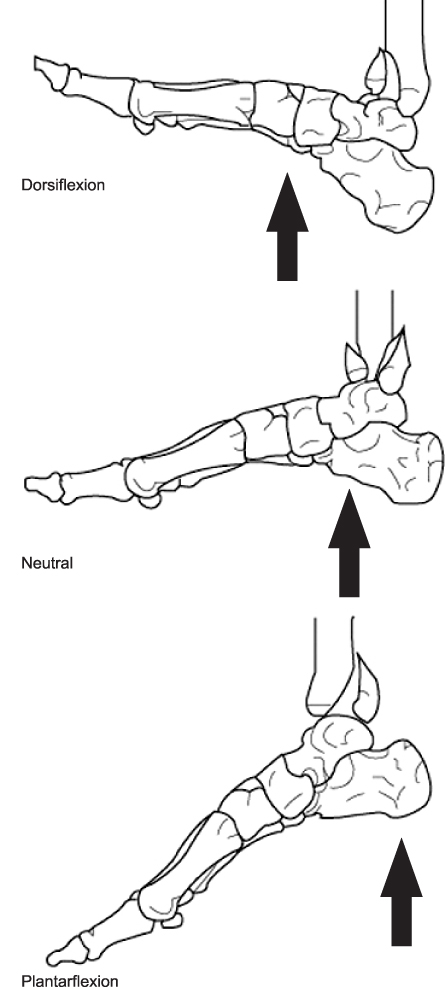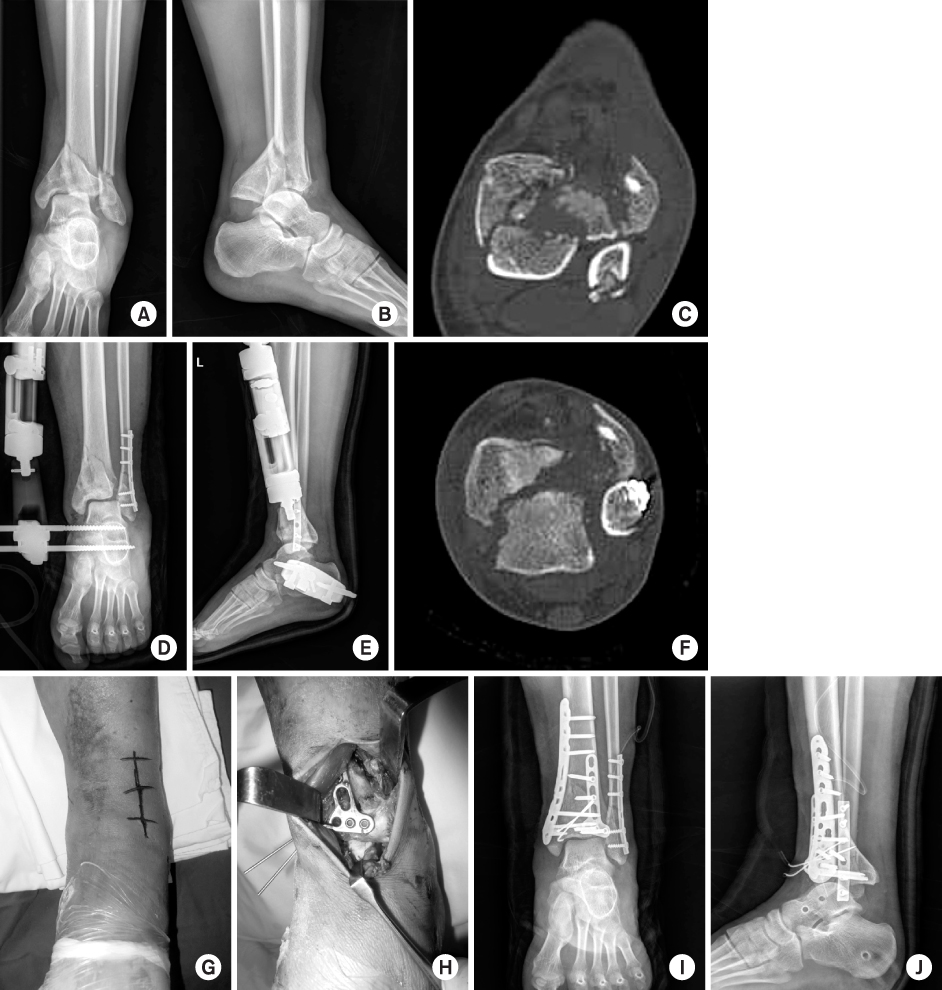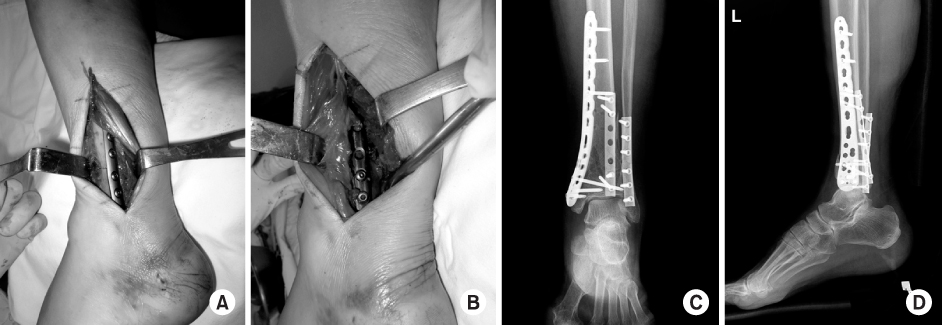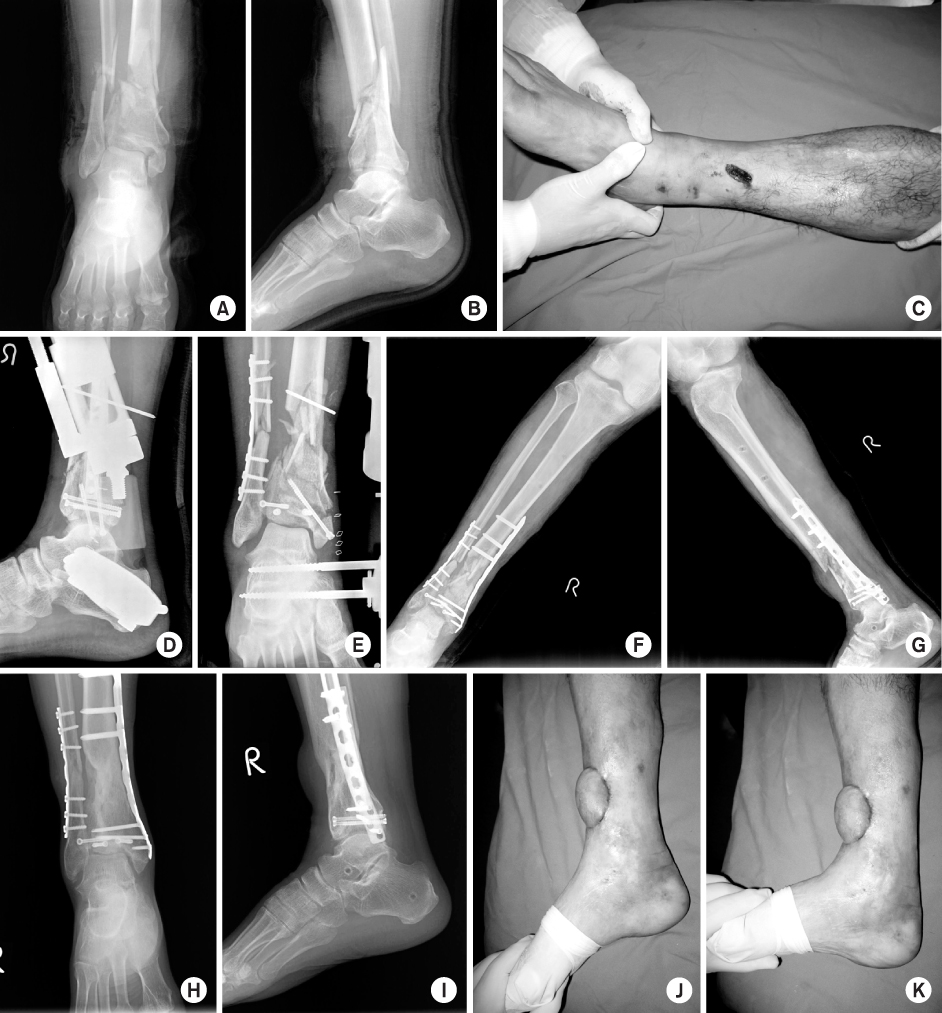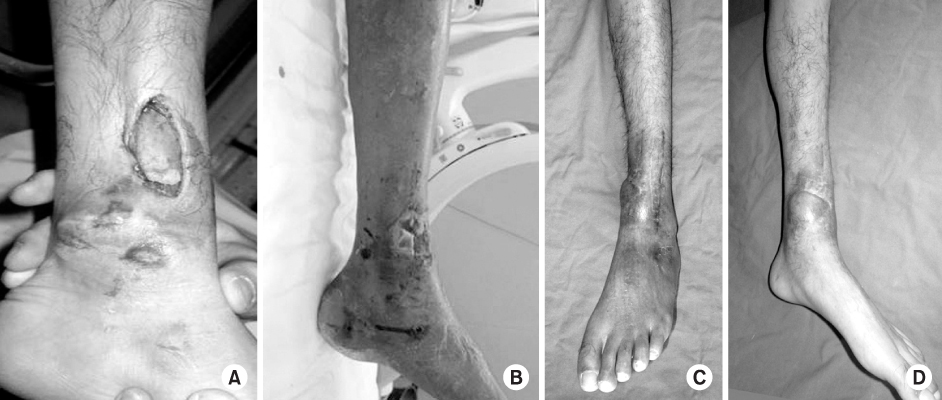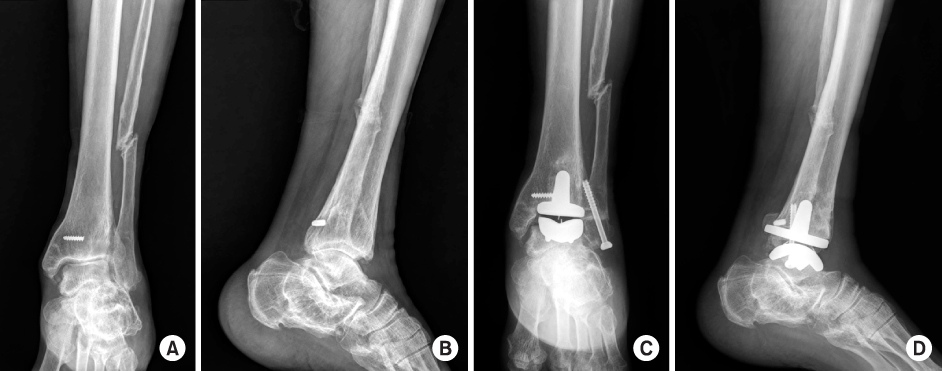J Korean Fract Soc.
2014 Apr;27(2):173-184. 10.12671/jkfs.2014.27.2.173.
Current Concepts in Management of Pilon Fracture
- Affiliations
-
- 1Department of Orthopaedic Surgery, School of Medicine, Chosun University, Gwangju, Korea. leejy88@chosun.ac.kr
- KMID: 1703118
- DOI: http://doi.org/10.12671/jkfs.2014.27.2.173
Abstract
- No abstract available.
Figure
Reference
-
1. Ovadia DN, Beals RK. Fractures of the tibial plafond. J Bone Joint Surg Am. 1986; 68:543–551.
Article2. Rüedi T, Matter P, Allgöwer M. Intra-articular fractures of the distal tibial end. Helv Chir Acta. 1968; 35:556–582.3. Barei DP, Nork SE. Fractures of the tibial plafond. Foot Ankle Clin. 2008; 13:571–591.
Article4. Bourne RB, Rorabeck CH, Macnab J. Intra-articular fractures of the distal tibia: the pilon fracture. J Trauma. 1983; 23:591–596.5. Egol KA, Wolinsky P, Koval KJ. Open reduction and internal fixation of tibial pilon fractures. Foot Ankle Clin. 2000; 5:873–885.6. Tornetta P 3rd, Gorup J. Axial computed tomography of pilon fractures. Clin Orthop Relat Res. 1996; (323):273–276.
Article7. Rüedi TP, Allgöwer M. The operative treatment of intra-articular fractures of the lower end of the tibia. Clin Orthop Relat Res. 1979; (138):105–110.
Article8. Tscherne H, Gotzen L. Fracutres with soft tissue injuries. Berlin, Heidelberg, NewYork, Tokyo: Springer-Verlag;1984. p. 103–117.9. Tull F, Borrelli J Jr. Soft-tissue injury associated with closed fractures: evaluation and management. J Am Acad Orthop Surg. 2003; 11:431–438.
Article10. Wagner HE, Jakob RP. Plate osteosynthesis in bicondylar fractures of the tibial head. Unfallchirurg. 1986; 89:304–311.11. Wyrsch B, McFerran MA, McAndrew M, et al. Operative treatment of fractures of the tibial plafond. A randomized, prospective study. J Bone Joint Surg Am. 1996; 78:1646–1657.
Article12. Coonrad RW. Fracture-dislocations of the ankle joint with impaction injury of the lateral weight-bearing surface of the tibia. J Bone Joint Surg Am. 1970; 52:1337–1344.
Article13. Schatzker J, Tile M. The rationale of operative fracture care. 3rd ed. Berlin: Springer-Verlag;2005. p. 523–550.14. Gould JS. Reconstruction of soft tissue injuries of the foot and ankle with microsurgical techniques. Orthopedics. 1987; 10:151–157.
Article15. Assal M, Ray A, Stern R. The extensile approach for the operative treatment of high-energy pilon fractures: surgical technique and soft-tissue healing. J Orthop Trauma. 2007; 21:198–206.
Article16. Mehta S, Gardner MJ, Barei DP, Benirschke SK, Nork SE. Reduction strategies through the anterolateral exposure for fixation of type B and C pilon fractures. J Orthop Trauma. 2011; 25:116–122.
Article17. Konrath GA, Hopkins G 2nd. Posterolateral approach for tibial pilon fractures: a report of two cases. J Orthop Trauma. 1999; 13:586–589.
Article18. Kao KF, Huang PJ, Chen YW, Cheng YM, Lin SY, Ko SH. Postero-medio-anterior approach of the ankle for the pilon fracture. Injury. 2000; 31:71–74.
Article19. Leonard M, Magill P, Khayyat G. Minimally-invasive treatment of high velocity intra-articular fractures of the distal tibia. Int Orthop. 2009; 33:1149–1153.
Article20. Tong D, Ji F, Zhang H, et al. Two-stage procedure protocol for minimally invasive plate osteosynthesis technique in the treatment of the complex pilon fracture. Int Orthop. 2012; 36:833–837.
Article21. Marcus MS, Yoon RS, Langford J, et al. Is there a role for intramedullary nails in the treatment of simple pilon fractures? Rationale and preliminary results. Injury. 2013; 44:1107–1111.
Article22. Wang C, Li Y, Huang L, Wang M. Comparison of two-staged ORIF and limited internal fixation with external fixator for closed tibial plafond fractures. Arch Orthop Trauma Surg. 2010; 130:1289–1297.
Article23. Sohn HM, Lee JY, Ha SH, Lee SH, Lee GC, Seo KH. The results of two stage surgical treatment of pilon fractures. J Korean Fract Soc. 2012; 25:177–184.
Article24. Collinge C, Sanders R, DiPasquale T. Treatment of complex tibial periarticular fractures using percutaneous techniques. Clin Orthop Relat Res. 2000; (375):69–77.
Article25. Thordarson DB. Complications after treatment of tibial pilon fractures: prevention and management strategies. J Am Acad Orthop Surg. 2000; 8:253–265.
Article26. Pollak AN, McCarthy ML, Bess RS, Agel J, Swiontkowski MF. Outcomes after treatment of high-energy tibial plafond fractures. J Bone Joint Surg Am. 2003; 85:1893–1900.
Article27. Mader JT, Shirtliff M, Calhoun JH. Staging and staging application in osteomyelitis. Clin Infect Dis. 1997; 25:1303–1309.
Article28. Zalavras CG, Patzakis MJ, Thordarson DB, Shah S, Sherman R, Holtom P. Infected fractures of the distal tibial metaphysis and plafond: achievement of limb salvage with free muscle flaps, bone grafting, and ankle fusion. Clin Orthop Relat Res. 2004; (427):57–62.29. Feldman DS, Shin SS, Madan S, Koval KJ. Correction of tibial malunion and nonunion with six-axis analysis deformity correction using the Taylor Spatial Frame. J Orthop Trauma. 2003; 17:549–554.
Article30. Cierny G 3rd, Cook WG, Mader JT. Ankle arthrodesis in the presence of ongoing sepsis. Indications, methods, and results. Orthop Clin North Am. 1989; 20:709–721.31. Morrey BF, Wiedeman GP Jr. Complications and long-term results of ankle arthrodeses following trauma. J Bone Joint Surg Am. 1980; 62:777–784.
Article32. Knecht SI, Estin M, Callaghan JJ, et al. The agility total ankle arthroplasty. Seven to sixteen-year follow-up. J Bone Joint Surg Am. 2004; 86:1161–1171.33. Clare MP, Sanders RW. Preoperative considerations in ankle replacement surgery. Foot Ankle Clin. 2002; 7:709–720.
Article34. Saltzman CL, Mann RA, Ahrens JE, et al. Prospective controlled trial of STAR total ankle replacement versus ankle fusion: initial results. Foot Ankle Int. 2009; 30:579–596.
Article35. SooHoo NF, Zingmond DS, Ko CY. Comparison of reoperation rates following ankle arthrodesis and total ankle arthroplasty. J Bone Joint Surg Am. 2007; 89:2143–2149.
Article
- Full Text Links
- Actions
-
Cited
- CITED
-
- Close
- Share
- Similar articles
-
- External Fixation and Limited Internal Fixation in AO Type C Pilon Fracture: Report of Five Cases
- A Clinical Study of tibial Pilon Fractures
- Treatment of Articular Fracture of the Distal Tibia (Pilon Fracture) with Limited Open Reduction and External Fixator
- Comparison of Biomechanical Stability of the Ilizarov External Fixation Methods for Treatment of Tibial Pilon Fractures
- Application & Use of an Ilizarov Technique for the Pilon Fracture

